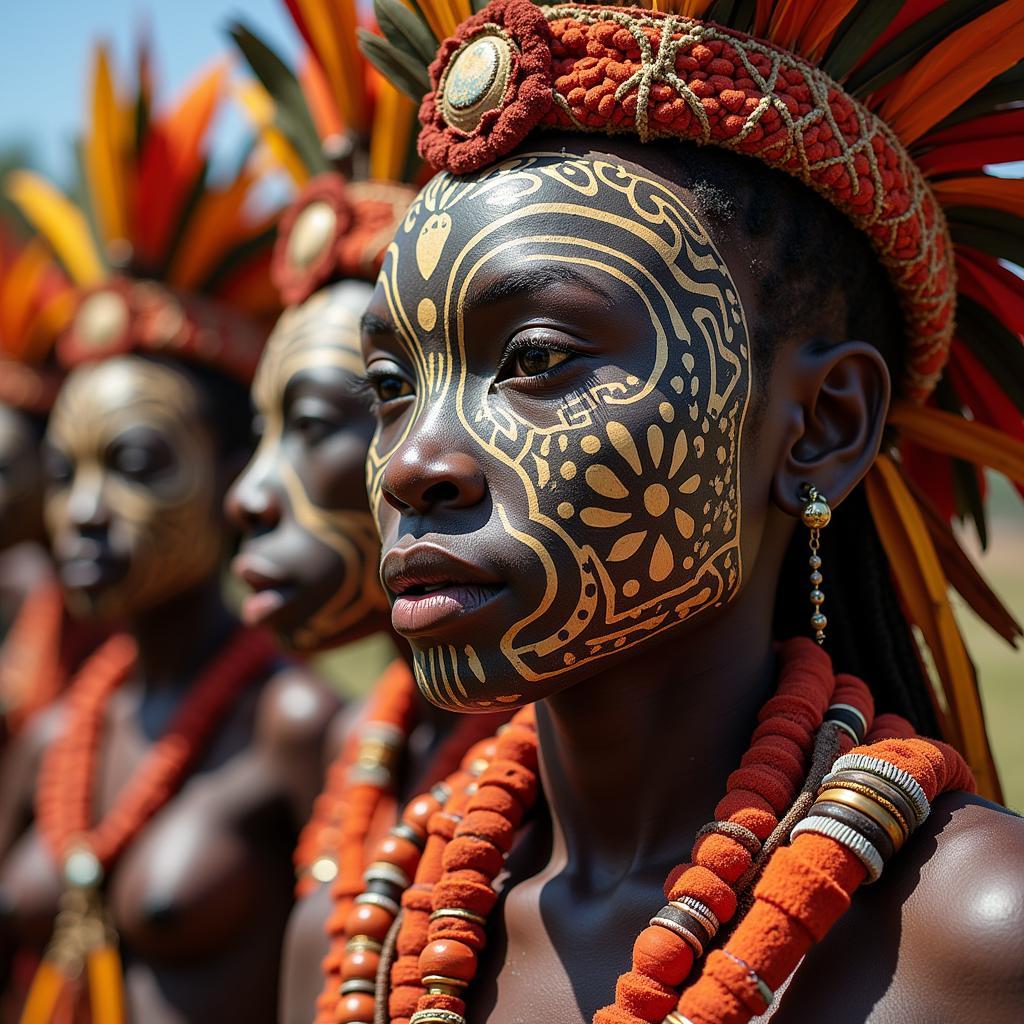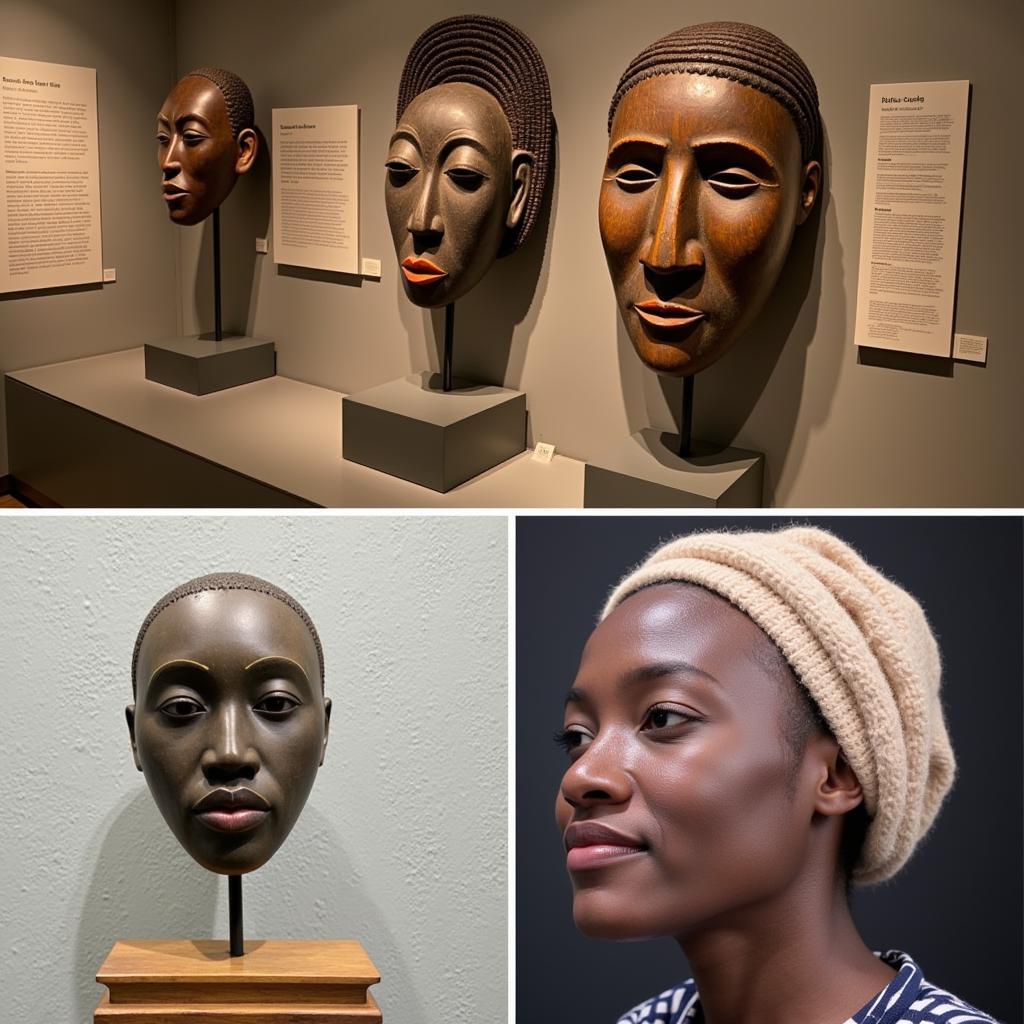Unveiling the Mysteries of Traditional African Masks
Traditional African Masks are more than just decorative objects; they are powerful symbols deeply embedded in the cultural, spiritual, and social fabric of diverse African communities. These masks, often used in ceremonies, rituals, and performances, offer a fascinating glimpse into the rich heritage and artistic traditions of the African continent.  Traditional African Mask Used in a Tribal Ceremony
Traditional African Mask Used in a Tribal Ceremony
The Significance of Traditional African Masks in Ritual and Ceremony
From celebrating harvests to honoring ancestors, traditional African masks play a vital role in various rituals. They are not merely seen as representations of spirits or deities but are often believed to embody the very essence of these beings. The wearer of the mask, often a trained dancer or community elder, becomes a conduit between the physical and spiritual worlds. This connection allows for communication with ancestors, deities, and the forces of nature, seeking guidance, blessings, or protection. african gold faces
These masks can represent a wide range of figures, including animals, mythical creatures, and ancestors. The specific design, materials, and colors used in the creation of a mask carry deep symbolic meaning, often reflecting the history, beliefs, and values of the community. For example, masks representing animals might symbolize strength, agility, or wisdom associated with that animal.
Exploring the Diverse Styles of Traditional African Masks
Across the vast continent of Africa, a stunning array of mask styles exists, each reflecting the unique artistic traditions of its region. From the bold, geometric designs of the Dan masks of Liberia to the elaborate headdresses of the Yoruba masks of Nigeria, each style tells a unique story.  Diverse Styles of Traditional African Masks from Different Regions
Diverse Styles of Traditional African Masks from Different Regions
Some masks are characterized by their large size and elaborate headdresses, while others are smaller and more minimalist. Materials used in mask making vary from wood and metal to feathers, beads, and animal hides. The choice of materials and techniques employed often reflects the available resources and cultural preferences of the community. african crafts in guyana For instance, some communities use specific types of wood believed to hold spiritual significance.
What are some common materials used in making traditional African masks?
Common materials include wood, metal, feathers, beads, animal hides, and natural pigments. The choice of materials often holds symbolic meaning and reflects the resources available within the community.
The Artistry and Craftsmanship of Traditional African Mask Makers
Creating traditional African masks is a highly skilled craft, often passed down through generations within families or specialized groups. The mask maker, known as a sculptor or artisan, is not merely a craftsman but also a spiritual leader and storyteller, imbuing the mask with meaning and power.
The process of creating a mask can involve intricate carving, painting, and embellishment. Mask makers often use traditional tools and techniques, passed down through generations, to create these stunning works of art. african art forms
Dr. Adeola Ogungbemi, a renowned art historian specializing in African art, explains, “The mask maker’s role extends beyond artistry; they are custodians of cultural memory, preserving and transmitting traditions through their creations.”
How are traditional African masks used today?
While still holding significant cultural and spiritual value, traditional African masks have also found their place in the modern world. They are appreciated as works of art, displayed in museums and galleries worldwide, showcasing the rich artistic heritage of Africa. african altar
Mr. Kwame Asante, a Ghanaian mask maker, states, “The demand for traditional masks continues, both from within our communities and internationally. It is a testament to the enduring power and beauty of our traditions.”  Modern Use of Traditional African Masks
Modern Use of Traditional African Masks
Traditional African masks continue to inspire contemporary artists, influencing various art forms, from painting and sculpture to fashion and design. Their enduring appeal lies in their ability to connect us to the past, celebrate cultural diversity, and remind us of the profound power of art and tradition.
In conclusion, traditional African masks are more than just beautiful artifacts; they are powerful symbols of cultural identity, spiritual belief, and artistic expression. From their role in ancient rituals to their influence on contemporary art, these masks offer a captivating window into the rich heritage of Africa. Exploring the world of traditional African masks provides a deeper understanding and appreciation for the diverse cultures and artistic traditions of this vibrant continent.
FAQ
- What is the purpose of traditional African masks?
- How are traditional African masks made?
- What materials are commonly used in making these masks?
- What do the different designs and symbols on the masks represent?
- Where can I see traditional African masks?
- Are traditional African masks still used today?
- How do traditional African masks influence contemporary art?
When you need assistance, please contact us by Phone: +255768904061, Email: [email protected] or visit our address: Mbarali DC Mawindi, Kangaga, Tanzania. We have a 24/7 customer service team.
